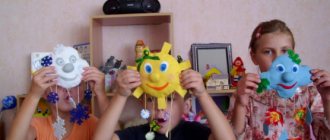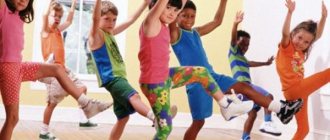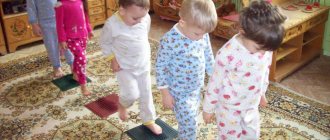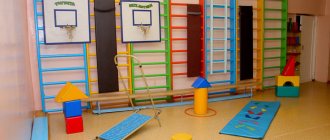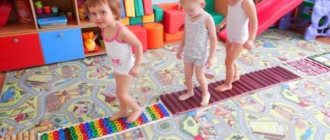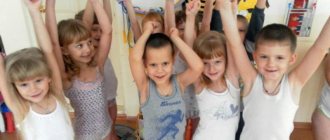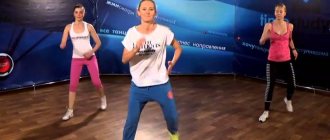Sleep plays a vital role in a child's daily routine. How the baby wakes up depends on his mood, state of health and how he will spend the rest of the day. In kindergarten, organizing a proper awakening is more difficult than for parents at home, because it is necessary for 15, 20, or even 30 people to throw off the shackles of Morpheus almost simultaneously, and to do it correctly. Solving such a problem is not easy, but with knowledge of some methodological nuances it is quite possible.
- 2 Types of gymnastics, or a little about the terms
2.1 Types of exercises
- 4.1 Table: card index of exercises after sleep
4.2.1 Video: gymnastics after waking up (middle group)
- 5.1 Table: sample analysis scheme
Goals, objectives and techniques
Gymnastics after sleep is a set of exercises that provide a smooth transition from calmness to wakefulness.
The objectives of such classes are:
- increase in muscle tone;
- improved mood;
- prevention of colds;
- strengthening the respiratory system;
- preventing the development of problems with posture, flat feet;
- fostering the habit of stretching the body after waking up.
Not only his mood, but also the emotional atmosphere of the entire group depends on how each child wakes up.
To achieve the goals, every day the teacher selects exercises to solve problems such as:
- toning the nervous system (that is, preventing irritability and anxiety that may arise after waking up);
- improving the functioning of the body’s main systems (cardiovascular, respiratory, as well as stabilizing the body’s protective functions);
- creating a positive atmosphere in the group.
All this is possible with the right combination of gymnastics techniques after sleep.
- The plot of the awakening. This technique is especially important for children of the first and second junior groups. The essence of the technique is that all exercises are carried out within the framework of a common plot. For example, a bear came to visit us and asked for help: her son Mishka could not wake up, and he needed to go to help his mother to pick raspberries for the winter - he needed to show by example how to quickly restore the body after sleep. In addition, it will be more interesting for children to perform certain actions accompanied by rhymes and short sayings.
- Musicality. Quiet, relaxing music, played a little louder than before bed, helps children of any age recover.
Gymnastics after waking up should be done to music
- Lying exercises. These complexes help to gradually restore muscle tone and move on to more active actions. Again, for children, more attention is paid to this block of exercises, since the younger the children, the more difficult it is for them to adapt to active activity after sleep.
- Active block of gymnastics (or “mat exercises”). It includes tasks that are performed while standing. The complex includes swinging arms, legs, body turns, squats, walking on massage mats, etc. For children in older groups, tasks such as complexes play a very important role in developing correct posture.
- Breathing exercises. For children of the middle - preparatory groups, this is almost the most important stage of work, since, in addition to the task of general strengthening of the body and the respiratory system in particular, exercises help develop correct sound pronunciation, which is very important for children who are fully mastering speech or those who have problems with the speech apparatus.
More information about gymnastics after sleep in the preparatory group can be found in our article - We conduct gymnastics after sleep in the preparatory group of the kindergarten.
Types of gymnastics, or a little about the terms
Gymnastics after sleep in some sources is called corrective, and sometimes includes corrective in its range of types.
This is interesting. Corrective gymnastics (from the Latin corrigo - straighten, correct) is a type of therapeutic gymnastics - special exercises to eliminate postural disorders; it also has a general strengthening effect (trains the functions of the cardiovascular and respiratory systems, strengthens individual muscle groups); restores balance between the curvatures of the spine.
Based on the definition, which includes the main goals and objectives of performing exercises after sleep, we can conclude that gymnastics after sleep, invigorating and corrective are all terms of the same synonymous series. Types of corrective exercises can be:
- correctional exercises (exercises aimed at correcting some specific disorders in the functioning of the child’s body, for example, flat feet or curvature of the chest);
- hardening (except for walking, hardening is not the lot of many people, because this is a special type of health procedures, which is carried out, as a rule, in specialized groups, it includes washing with cold water, dousing on the street, etc.);
- lazy gymnastics (exercises that are performed lying down, sitting, without sudden movements of strong physical exertion);
- physical education minutes (conducted regularly during breaks during classes, so that children not only take a break, but also work to strengthen the body);
- preventive gymnastics (a universal set of exercises that is most often used in preschool institutions).
This is interesting. Preventive gymnastics is sometimes called invigorating.
Types of exercises
If we talk about corrective gymnastics after sleep, it includes:
- exercises immediately after waking up - in bed;
- exercises using exercise equipment (for example, massage mats, balls, etc.);
- corrective tasks to prevent flat feet, spinal curvature, etc.;
- breathing exercises.
Hardening
Hardenings are carried out if they are developed and reinforced by the preschool educational institution program. At the same time, the methods should be individually focused on each student, taking into account the health characteristics of each child. If there are many children in a group and an individual program is not possible, the following moderate hardening technique is recommended.
Some of the active exercises in the summer are carried out outdoors; in the colder season, children perform gymnastics in a cool room (18–20 °C) without shoes, wearing T-shirts and panties. Health-improving walking barefoot on rubber massage mats is carried out, alternating with steps into basins of water. You can complete the gymnastics complex by washing your face, hands, neck, and chest.
Hardening trains the body's defenses, which will make the child less susceptible to changing environmental factors
In summer, dousing with water at room temperature is acceptable. Children will also benefit from dosed sunbathing during the warm period from 9:00 to 11:00. The time should gradually increase from 3 to 20 minutes.
Rules for conducting invigorating gymnastics
To prepare children for the period of wakefulness in the afternoon, it is worth following a number of recommendations developed by the experience of teachers:
- The air temperature in the bedroom should not be lower than +16/+18 degrees.
- You need to choose a set of exercises taking into account the activities you had before going to bed. For example, before lunch the kids had a story game, which means that after sleep they can pay more attention to a block with squats, jogging, and body turns.
- For those little ones who wake up earlier, it would be a good idea to prepare 1-2 sets of exercises, for example, the “lazy” type.
Children who wake up earlier should be occupied with exercises so that they do not wake up those who are still sleeping.
- Children should wear shorts and a T-shirt. If we are talking about the cold season, then pajamas. To perform exercises on the mat, you should wear shoes or socks.
- No coercion. If the little sun refuses to work together with everyone, then you absolutely cannot scold him. You just need to find out what caused this behavior.
- In the summer, a block of active exercises is recommended to be carried out outdoors.
- During the exercises, relaxation should be longer than tension.
- Instructions for implementation should be repeated more or less times depending on the emotional state of the kids.
Gymnastics for children 4-6 months
Unconditioned reflexes gradually fade away, so the proportion of passive-active exercises increases. The number of repetitions of the same exercise also increases.
Passive exercises are performed - flexion and extension in large joints.
Circular movements in the hip joints, with the obligatory fixation of the child’s knees with your own hands.
Simultaneous flexion - extension of the legs.
Starting position: on your back. You should grab the child's legs at the bottom of the lower leg from behind, holding the feet. Bend your legs at all joints, pressing them lightly towards your stomach (the baby's knees should be spread apart), then straighten the baby's legs.
Connection of opposite and identical knee-elbow.
The range of exercises on the ball is expanding.
At this age, many children swing with interest on the ball while lifting the toy from the surface.
On the ball in a position on the back, you can rock the baby with a slight “squat” when the legs reach support.
From 5 months, you can rock the baby on its side, pushing off the support surface.
Methodology
If we summarize the above-mentioned features of the organization of corrective gymnastics, we can come to the conclusion that the optimal ratio would be a combination of 2-3 exercises in bed, 1-3 on the floor or on a rug and 2-3 breathing exercises performed to calm music (for example, sounds of nature or classics). In general, it will take 5–10 minutes to complete the gymnastics.
Spending 5-10 minutes after sleep helps maintain and improve children's health
Table: card index of exercises after sleep
| date | Exercise name | Description |
| September | Gymnastics in bed | |
| "Bike" | I. p.: lying on your back, “turn the pedals with the sound “w-w-w” (6 times) | |
| "Kitty" | I. p.: lying in the position of a sleeping cat, purr. The kitten kneels down and arches its back with the sound “sh-sh-sh” (6 times). | |
| "Hand massage" | I. p.: sitting, legs crossed. We wash our hands, rub our palms vigorously until a strong feeling of warmth is felt, apply pressure on each finger (6 times). | |
| Exercises on the mat | ||
| Children imitate movements in accordance with the text 3–4 times | I ask you to get up - that's one thing, Turning your head - that's two. Hands down, look forward - that's three. Hands to the sides - four, Press them firmly to the shoulders - five. All the guys sit down quietly - that's six. | |
| Walking along corrective and salt paths. | ||
| Breathing exercises | ||
| "Growl" | Growl for a long time as you exhale, baring your teeth, bending your tense fingers like claws. | |
| "Angry Dog" | Inhale sharply through the mouth, pronouncing “rr...”, with a simultaneous sharp blow of the hands overlapping the back (while standing, bending over). Exhale the same way through the nose. | |
| October | Gymnastics in bed | |
| "Stretch" | I. p.: lying on your back. We stretch our heels forward and both hands up (6 times). | |
| "Cheburashka" | I. p.: sitting cross-legged. We sculpt ears for Cheburashka, stroke the ears (“we apply clay” so that the ears do not come off (6 times). | |
| "Pinocchio" | I. p.: sitting on my knees, we sculpt a beautiful nose for Pinocchio. Pinocchio draws “sun”, “carrot”, “house” with his nose (6 times). | |
| Exercises on the mat | ||
| Children imitate the movements and repeat 3-4 times. | They jump and jump in the woods, Hares are gray balls, Jump - hop, jump - hop. The little bunny stood up on a stump, lined everyone up in order, and began showing exercises. Once - everyone walks in place. Two - they wave their hands together. Three sat down and stood up together. We reached four. Five - bent over and bent over. The six all stood in a row again, They walked like a detachment. | |
| Walking along corrective and salt paths. | ||
| Breathing exercises | ||
| "Penknife" | I. p.: lying on your back. As you exhale, bend your torso toward your legs, which do not lift off the floor. Pronounced while exhaling “Ha! " Repeat 3-4 times. | |
| "Pump" | I. p. - standing, hands in front of the chest, fingers clenched into fists. Leaning down with straight legs, exhale, saying [w]. As you straighten up, inhale through your nose. Repeat 6–8 times. | |
| “Who is better at inflating a toy?” | Inhale through the nose (1-4, exhale slowly through the mouth, into the hole of the toy (1-8). | |
| April | Gymnastics in bed | |
| "Delight" | I. p.: lying on your back. Stroking in the chest area with the words: “I am sweet, wonderful, beautiful.” (6 times). | |
| "Sipping" | I. p.: lying on your back. We pull the left leg with the heel forward, the right arm up along the body; pull the right leg with the heel forward, the left arm up, along the body (6 times). | |
| "Dough mixer" | I. p.: sitting cross-legged. The child strokes the belly clockwise, pats it with the edge of his palm, with his fist, strokes it again, pinches it, imitates the movements of a dough mixer kneading dough, strokes it again. (6 times) | |
| Exercises on the mat | ||
| Children imitate movements in accordance with the text 5–6 times | Here comes a black cat, (steps with legs raised high) Hidden - waiting for the mouse. (squats, hands to knees) The mouse will go around the mink, (stand up, turn around) And will not approach the cat (arms to the sides). | |
| Walking along corrective and salt paths. | ||
| Breathing exercises | ||
| "The nose is walking" | Inhale and exhale through the nose. Perform 10 – 20 times. | |
| "The nose is playing around" | When inhaling, press on the wings of the nose (prevent inhaling). Perform 10 – 20 times. | |
| “The nose smells pleasant smells” | Alternately close your nostrils with your fingers and take a deep breath. Perform 10 – 20 times. | |
| "The nose sings a song" | As you exhale, tap the wings of your nose and say ba, bo, bu. Perform 10 – 20 times. | |
This complex can be called universal, since it is aimed at preventing health problems. As for age characteristics, the differences will be in the frequency of execution and the number of exercises. So, for the first younger group, the “Exercises in bed” block remains unchanged, but the second and third blocks can be shortened.
Visibility for gymnastics
As is known, in preschool children the visual-figurative perception of the world is in the lead. Completion of tasks should be accompanied by bright, appropriately sized:
- pictures;
- soft toys;
- slides;
- posters.
The leading position remains with the toy. The fact is that children perceive her as a friend, comrade, which means they are more willing to complete the task. For younger groups, such a character serves as a role model, and for older groups - a younger comrade who needs the help of older friends.
If it is possible to show the kids slides, for example, with the hero who came to wake them up today, then such a transition to wakefulness will be easy and healthy.
A massage mat can also be used as a visual aid: for example, if it is a forest path or a bridge over a river
Video: gymnastics after waking up (middle group)
Gymnastics for children from 0 to 3 months
The optimal age at which it is recommended to start a course of massage and gymnastics is discussed in the article “general principles of massage.” Massage and gymnastics for children of the first year of life
Breathing exercises
Breathing exercises are very important for babies of this age. They promote the development of respiratory muscles, the physiological abilities of the respiratory system, its reserve capabilities, and serve as the prevention of respiratory diseases.
Starting position: the child is in the mother’s arms, facing her. Apply rhythmic pressure with the palm of your hand on the child’s back, moving the palm from the neck to the lower back.
Starting position: the child lies on his back. Alternately moving the handles to the side and up, starting from three months you can perform this exercise with two handles at the same time.
Reflex exercises
Infants have a certain physiological feature of the nervous system - the presence of unconditioned reflexes that appear and disappear at certain times.
Thus, a special group of exercises can be distinguished for infants. These are reflex exercises. They are based on the special evocation of certain unconditioned reflexes.
Naturally, no one will induce the Moro reflex as an exercise (a loud blow on the surface on which the child is lying, while he makes a “hugging” movement).
But some of them, for example the Babinski reflex (special stroking of the foot) or the support reflex are very useful as developmental exercises.
The number of repetitions of reflex exercises during the lesson is 1-2 times.
The exercise is based on the Babinski reflex.
Starting position: the child lies on his tummy.
Apply pressure on the sole at the base of the toes - the child will reflexively bend the toes, then move along the inner edge of the foot to the heel and the outer edge to the little toe - the sole is extended. The movement is performed with the adult's thumb. Repeat 1-2 times. Important! When performing the exercise, the child’s leg is always fixed at the ankle joint (not at the toes).
Reflex exercises at this age also include reflex crawling, reflex support and reflex walking. These exercises are usually carried out at the end of the lesson.
Reflex crawling
The exercise is based on the Bauer crawling reflex.
Starting position: on your stomach. An adult’s palm is placed under the child’s feet, so that the child can rest his slightly bent legs against it. The child pushes and straightens, moving forward. Repeat 1-2 times. Important! Don't forget to leave a clear space where the baby will make this movement (so that he doesn't hit his head).
Reflex support and walking
Starting position: the child is in an upright position, the adult’s hands are in the child’s axillary areas. The child should be allowed to rest his feet completely on the surface of the table. Slightly tilt the child's torso forward, and he will reflexively take several steps.
Laying on the stomach is useful; this is also an exercise for the child, based on the protective reflex (the baby raises and turns his head to the side). In the “on the stomach” position, the muscle tone of the extensors is stimulated, the abdominal muscles are toned, the work of the intestines is stimulated - the removal of “gas” is facilitated, and it prevents constipation.
Laying on the stomach is recommended daily, starting from 30 seconds and up to 15-20 minutes in the first months of life.
Passive exercises
Sliding steps - “stomp”
Starting position: on your back. The leg is bent at the knee and hip joints, the foot rests on the table, and the foot slides along the surface of the table.
Riding in the “embryo” position.
Starting position: the child lies on his back. The legs are bent, brought to the tummy, the head is also bent, the chin is brought to the chest. The baby is “rolled” in this position on his back. As a rule, children really like this exercise.
Active exercises
Various bright, sounding toys are used, which are shown to the child at a distance of 25-30 cm, thus stimulating eye tracking of an object, auditory concentration, and an attempt to grasp the object.
Scheme of analysis of gymnastics after sleep
To understand whether conducting exercises after sleep in a particular kindergarten group is effective, you need to evaluate each of the stages of its implementation according to the scheme. First you need to specify:
- name of the preschool institution and group;
- teacher's name;
- date;
- age of children;
- number of children in the group.
Table: sample analysis scheme
| No. | Gymnastics stage | List and description of exercises | Time frame | Conclusion (goals achieved or not) | Notes |
| 1 | Start of the climb, toilet | 3 minutes | |||
| 2 | Exercises in bed | ||||
| 3 | Exercises on the mat | 4 minutes | |||
| 4 | Breathing exercises | 3 minutes | |||
Gymnastics after sleep is very important for children. After all, with its help, kids not only restore their tone, but also learn to take care of their health. And maintaining and restoring the child’s normal well-being is one of the main tasks of his stay in a preschool educational institution.
Gymnastics for children 3-4 months old
In order to avoid repetition, we will add to the above exercises a description of new elements of gymnastics.
Breathing exercises
Starting position: on your back. Simultaneous movement of the arms up and down and circular movements with the arms are added.
Boxing exercise
Starting position: on your back. With your arms bent at the elbows, they are alternately straightened. The movements are reminiscent of boxing. Important! The handles are fixed in the wrist joints to prevent sprains.
Half-turns and turns from back to stomach and back
Starting position: on your back. One hand clasps the child's shins from below, the index finger of the adult's other hand is placed in the baby's palm, and the remaining fingers cover his hand. Then, slightly straightening the child’s legs, you should turn his pelvis, after which the child turns his head and shoulder girdle. Make turns in both directions in a similar manner.
Exercises on the ball
Starting from 3 months, you can introduce a new type of activity - exercises on the ball. For these exercises you will need a ball with a diameter of 50-60 cm, slightly deflated.
Swinging on the ball promotes the development of coordination, the vestibular apparatus, and helps to tone the abdominal muscles, back, and legs.
The baby is placed on the ball in different ways: on the back, on the tummy, and alternately on the sides.
Swings are performed with support on the legs, with legs raised.
It is important to remember to securely secure the child on the ball.
